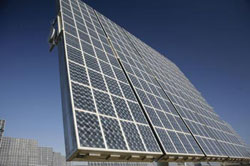Solar farms with concentrating solar technologies have the potential to contribute greatly to the world’s growing energy needs. As efficiencies in photovoltaic (PV) cells increase and silicon availability decreases, attention is turning toward concentrating the sun’s energy using multijunction cells.
A variety of concentrating photovoltaic (CPV) designs exist, but generally they consist of a system of reflective optics – either mirrors or Fresnel lenses – that concentrate the sun onto PV cells. Tracking systems keep the solar arrays precisely facing the sunlight throughout the day.

Concentrating PV is best suited for ground-based installations in the sunniest of locations, such as this site in Spain. Photo courtesy of Guascor Foton.
Multijunction cells have achieved the highest efficiencies of all types of PV cells, and labs around the world continue to leapfrog each other in announcing higher and higher numbers. For example, Fraunhofer Institute for Solar Energy Systems in Freiburg, Germany, recently announced an efficiency of 41.1 percent using GaInP/GaInAs/Ge on a germanium substrate. Compare that with 27.6 percent for a silicon-based solar cell. Multijunction cell efficiencies will approach 50 percent by 2015, with an overall system efficiency of up to 30 percent, according to a study done by the University of Jaén in Spain in conjunction with the professional society CPV Today which is based in London.
Show me the money
Cost is still a factor with any form of solar. According to the report “Achieving Grid Parity” from CPV Today, the costs of CPV are expected to drop 62 percent by 2015 and could reach grid parity by 2011. But first the systems have to be installed, and a major impediment to that is financing.
Obtaining financing is a double-edged sword. There are not many CPV installations, and those that are up and running are still relatively new compared with other forms of solar. According to Reese Tisdale, research director at Emerging Energy Research in Cambridge, Mass., “Banks are risk-averse.” When presented with a menu that includes concentrating solar power (CSP), CPV and then silicon-based PV that’s been operating for 25 years, banks are going to look at what’s proven and operationally viable. With so little CPV installed, it’s hard to prove its long-term viability; yet, with financing, CPV could take off and become competitive at the utility scale. According to analysts at GreenTech Media Inc. and the Prometheus Institute for Sustainable Development, both in Cambridge, Mass., this could happen within the next decade. Tisdale noted that for CPV to take off at this point, “They just need to get over the hump and get it installed.”
Location, location, location
Only the sunniest areas are best for planting CPV, as the design concentrates normal direct solar irradiation. The US government’s National Renewable Energy Lab has studied the best areas for renewable energy resources and recently updated its list. Location is critical to CPV. In addition to sunny conditions, the climate must offer a “direct beam resource,” or a straight shot at the sun. This is one reason that some of the largest installations are in Spain and Greece.
Multiple CPV installations are under construction now in Greece, where SolFocus of Mountain View, Calif., is partnering with Samaras Group, a consultancy based in Greece, to provide a total of 1.6 MW of electricity.
Pushing ahead
It’s unfortunate that CPV installations are few and far between, because of the many advantages of this renewable energy resource. Key drivers include proven technology, modularity of systems, minimal use of water and potential high efficiency, according to the recent report “CPV: Searching for the Sun” from Emerging Energy Research. CPV has yet to be embraced by the large utilities that – right now – prefer concentrated solar thermal and flat panel PV.
According to Keith Emery, device performance team leader at the National Renewable Energy Lab in Golden, Colo., utilities don’t quite get CPV and are more likely to go with a CSP plant, which produces steam that drives an engine to produce electricity – a method with which they’re more familiar. Thermal also appears to offer more storage capability than the PV approach, although in practical use, storage is not much of an issue with CPV because the power is used when it’s generated. Tisdale pointed out that storage is an issue on a case by case basis. Some utilities demand it, while others are content covering peak demand.
A further challenge is the lack of standards and approvals. The International Electrotechnical Commission does have performance, qualification and safety standards; however, so far few modules have received its stamp of approval.
CPV is not alone in dealing with technical, cost and regulatory issues, in addition to switching mindsets. Some see CPV in competition with other renewable energy sources, but by resolving the various issues with each, they’ll all take part in contributing to the world’s energy needs.